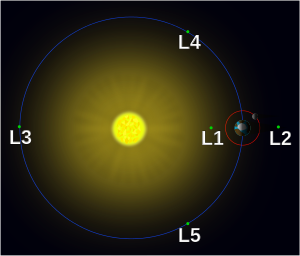
Back Lagrange-punt Afrikaans Puntos de Lagrange AN نقاط لاغرانج Arabic Puntos de Lagrange AST Laqranj nöqtələri Azerbaijani Пункты Лагранжа Byelorussian Точки на Лагранж Bulgarian লাগ্রঁজ বিন্দু Bengali/Bangla Lagrangeova tačka BS Punt de Lagrange Catalan



WMAP · Earth
| Part of a series on |
| Astrodynamics |
|---|
In celestial mechanics, the Lagrange points (/ləˈɡrɑːndʒ/; also Lagrangian points or libration points) are points of equilibrium for small-mass objects under the gravitational influence of two massive orbiting bodies. Mathematically, this involves the solution of the restricted three-body problem.[1]
Normally, the two massive bodies exert an unbalanced gravitational force at a point, altering the orbit of whatever is at that point. At the Lagrange points, the gravitational forces of the two large bodies and the centrifugal force balance each other.[2] This can make Lagrange points an excellent location for satellites, as orbit corrections, and hence fuel requirements, needed to maintain the desired orbit are kept at a minimum.
For any combination of two orbital bodies, there are five Lagrange points, L1 to L5, all in the orbital plane of the two large bodies. There are five Lagrange points for the Sun–Earth system, and five different Lagrange points for the Earth–Moon system. L1, L2, and L3 are on the line through the centers of the two large bodies, while L4 and L5 each act as the third vertex of an equilateral triangle formed with the centers of the two large bodies.
When the mass ratio of the two bodies is large enough, the L4 and L5 points are stable points, meaning that objects can orbit them and that they have a tendency to pull objects into them. Several planets have trojan asteroids near their L4 and L5 points with respect to the Sun; Jupiter has more than one million of these trojans.
Some Lagrange points are being used for space exploration. Two important Lagrange points in the Sun-Earth system are L1, between the Sun and Earth, and L2, on the same line at the opposite side of the Earth; both are well outside the Moon's orbit. Currently, an artificial satellite called the Deep Space Climate Observatory (DSCOVR) is located at L1 to study solar wind coming toward Earth from the Sun and to monitor Earth's climate, by taking images and sending them back.[3] The James Webb Space Telescope, a powerful infrared space observatory, is located at L2.[4] This allows the satellite's large sunshield to protect the telescope from the light and heat of the Sun, Earth and Moon. The L1 and L2 Lagrange points are located about 1,500,000 km (930,000 mi) from Earth.
The European Space Agency's earlier Gaia telescope, and its newly launched Euclid, also occupy orbits around L2. Gaia keeps a tighter Lissajous orbit around L2, while Euclid follows a halo orbit similar to JWST. Each of the space observatories benefit from being far enough from Earth's shadow to utilize solar panels for power, from not needing much power or propellant for station-keeping, from not being subjected to the Earth's magnetospheric effects, and from having direct line-of-sight to Earth for data transfer.
- ^ Cite error: The named reference
Lagrange Cornishwas invoked but never defined (see the help page). - ^ Weisstein, Eric W. "Lagrange Points". Eric Weisstein's World of Physics.
- ^ "DSCOVR: In-Depth". NASA Solar System Exploration. NASA. Retrieved 2021-10-27.
- ^ "About Orbit". NASA. Retrieved 2022-01-01.